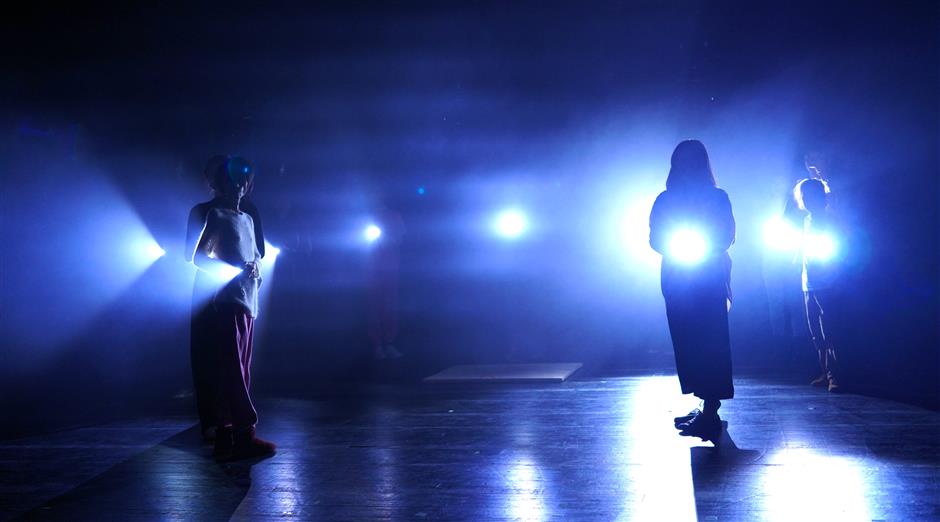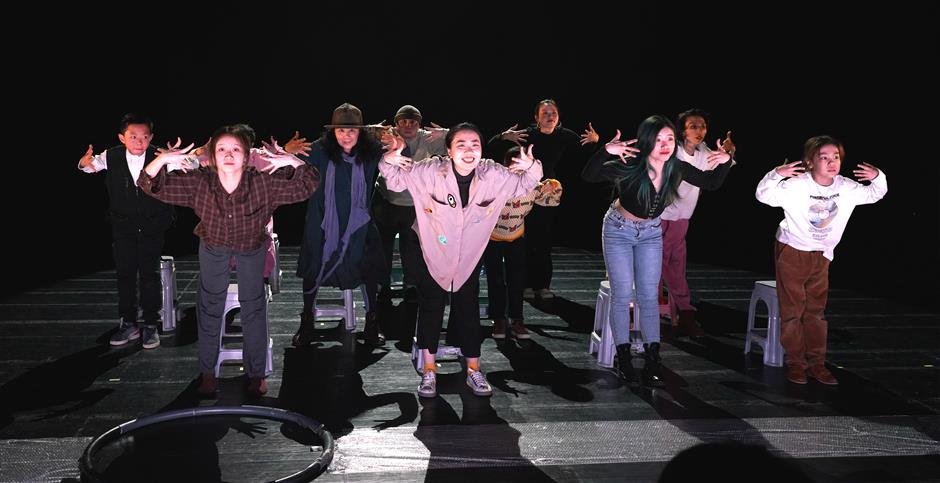Amateur dance group shows us how we can all share our emotions
Nine months ago, 38-year-old Du Juan was lying in a hospital intensive care ward, unable to move without help. A bulimia patient, Du lost her desire to live.
The psychological eating disorder, which occurs when people binge-eat and then vomit afterward to keep their weight down, damaged her intestines and stomach. Her weight dropped to 25 kilograms.
Into her somewhat somber life came a ray of hope when she got a call from the Shanghai International Dance Center several months ago.
The center wanted her to come in for an interview as a dancer for an amateur production entitled “The Vision of Yoyo.”
Du had responded to a general recruitment notice in July, with no expectations of being chosen.
“I was at rock bottom in my life, suffering physical pain and despair,” Du told Shanghai Daily. “I was even contemplating taking my own life, but I knew that would hurt my family, including my husband and daughter. Only cowards give up on living. I needed something to grasp onto.”

Du Juan (second right) is among the 12 dancers featured in "The Vision of Yoyo."
When she was first called in for an interview in August, she was grieving the death of her adoptive mother.
“When I received the call, I was in a terrible state, and I thought it was a prank call at first,” said Du. “But thankfully, they called again.”
In a sense, she’s a perfect fit for “The Vision of Yoyo,” which is aimed at presenting the ups and downs of the lives of ordinary people in the language of dance.
Du was born in Jiangxi Province in 1982 but was abandoned after birth. She was adopted by a Shanghai couple at age 3. She was initially diagnosed with bulimia when she was 23. The disease steadily grew worse.
Du started to work in a kindergarten in 2006, married in 2014 and gave birth to her daughter a year later. Her weight began to drop sharply since the beginning of last year.
Du said she was beset by feelings of inferiority, especially after seeing the physical condition and flexibility of other interviewees.
“Other applicants were warming up and doing splits, while I took a long time just to climb all the steps at the entrance of the theater hall,” she said. “But since I was already there, I was determined to present myself as courageously as possible.”

Du Juan
During the interview, participants were required to improvise dance movements to random music.
“I had learned folk dance in childhood, and the movements just came when I heard the music,” she said. “I wanted to stand on one leg to look like a swan or a peacock, but I was too weak to manage those movements. Standing on my toes with both feet was the best I could manage.”
She continued: “Eventually, I just closed my eyes, stretched my arms to the sky and started grabbing at the air, as if I was trying to grab a star. I imagined that star to be hope in my life. I was in tears at the end of my performance.”
According to director Song Xinxin, Du’s devotion and immersive performance impressed all the judges. She was one of 12 dancers selected for “The Vision of Yoyo.”
Two of the dancers chosen were professionals; two were dance students and the rest were all amateurs. The dancers were aged between 8 and 66, and came from all walks of life.
“We wanted to select amateur dancers from diverse aspects of life,” Song told Shanghai Daily. “They didn’t have to have outstanding dance skills, but they needed to be able to express themselves and show vitality.”

Dancers Wang Jiani (left) and Wang Shuhuan are dance school students.
Song said the purpose of recruiting amateurs is to show to the public that the art of dance belongs to everyone, professionals and amateurs alike.
“Everyone is equal, no matter whether their bodies have been trained or not,” Song said. “People can use their own movements for self-expression and enjoy the pleasure of dancing.”
She continued: “A number of famous dance artists, like Pina Bausch and Jerome Bel, have worked on amateur dance projects that question the stereotype of dancers as young, thin and well proportioned. We all grow old, and no one is perfect. To face that fact frankly is a kind of beauty in itself.”
Song said she often noticed a sanitation worker sitting in the park near the dance center, playing a tune on a leaf.
“He impressed me more than any other musician I see on TV because he’s practicing an art without any commercial motive,” she said. “That’s what I want ‘The Vision of Yoyo’ to become.”
The “Yoyo” in the production title refers to the name of a boy who took part in an online course by the dance center. He sent a video of himself dancing as homework, and it inspired the creation of an amateur dance show.
The center initially planned to center the production on Yoyo’s life, with him a featured dancer. But the boy’s family nixed the plan. He may not be appearing, but his spirit permeates the concept of the show.

Director Song Xinxin
When the production was in its first stages of creation, Song spent hours talking with the various dancers to dig out their personal stories. The performance will feature a group dance of all 12 performers and also individual presentations. Some segments are accompanied by monologues.
The dancers are not only from different walks of life, but also from different parts of the country. They have been gathering in Shanghai on weekends for training and rehearsals since October.
Dancer Wang Qinyu, 10, and his sister Wang Yuying, 8, are from Harbin, capital of the northeasternmost province of Heilongjiang. They were flying down to rehearsals every weekend until COVID-19 cases were reported in Heilongjiang last month. They managed to spend the winter school holidays in Shanghai to make up for lost time.
“I have been doing street dancing for three years,” said Wang Qinyu. “I have taken part in competitions but never in a performance. For me, a performance is the chance to express my emotions and make audiences feel them.”
Dancer Xiang Qing, 66, is a painter. She was traveling in Tibet when she learned of the dance center’s recruitment notice.
“I have never had professional dance training,” Xiang said. “I believe dancing is part of human nature. I have cultivated an unrestrained personality since childhood. I wanted to dance, so I applied. I enjoy spending time with all the younger dancers.”

The dances will portray the ups and downs of ordinary people’s lives.
Wang Sijia, 37, used to be a professional dancer. She started dancing at age 7 and joined Shanghai Dance Troupe after graduating from dance school.
“I left the stage and gave birth to two babies,” said Wang. “But I’m infatuated with dancing, and I missed the stage so very much in the eight years I was absent. So I decided to restart my career as a choreographer.”
She added: “I may not have the same stamina as I had in the past, but my maturity and life experiences help in my choreography.”
Jiang Mengying, 26, is a PhD student in neurobiology. She considers dancing as a sport as well as a method of self-healing.
“I’m an extremely emotional person,” said Jiang. “Dancing is filled with fun and challenge. Most importantly, it drives away the discomposure, fury and struggles inside me. Like other forms of art, it is where I can find my spiritual world.”
According to Song, it took some deep talks with Jiang for her to reveal her inner struggles.
“She has been bothered by anxieties and pressures, and a contradiction between personality and reality,” said Song. “Everyone has a rich and complicated inner world.”

Dancers don’t have to be trained professionals to express themselves and share their emotions with audiences.
Other dancers include 12-year-old dance lover Xu Wangrongping; 40-year-old street dancer Hu Hongjun; 25-year-old freelancer Ye Yiqing from Guangzhou; 31-year-old commercial analyst Wu Jiajing from Hangzhou; and dance school students Wang Jiani, 18, and Wang Shuhuan, 17.
In “The Vision of Yoyo,” some dancers will present their personal stories, some will dance to express their emotions, and some, especially the younger performers, will simply showcase the innocence of passion.
Wang Sijia will lead and support Du in a segment telling Du’s personal story.
“At first, I had hesitations about talking about bulimia or sharing my personal stories,” said Du. “But they are the realities I have to face and conquer. I don’t have stage experience. My 5-year-old daughter accompanied me to two rehearsals to give me encouragement.”
Apart from intermittent body pain and poor stamina, Du had to overcome her tendency to tire easily.
“Dancing has become the light of my life,” she said. “It is helping me to rebuild self-confidence and has renewed a desire to live life. I believe I will conquer my eating disorder if I can keep myself in a positive mood.”

Wang Sijia (right) will help Du Juan tell her personal story in dance.
For director Song, who is working with amateur dancers for the first time, the challenge is to present the diversity of each dancer and finding an axis to connect their stories.
“Communication is important because everyone has different opinions about how to present their individual segments,” she said. “The creative process consumes a lot of energy, but I believe in an artistic production inspired by the realities of common lives.”
“The Vision of Yoyo” is expected to be performed in May at the Shanghai International Dance Center and will be part of the center’s Amateur Dance Theater series.
“I hope the dance will evoke warmth and courage for audiences,” Song said. “Life is hard, but worth living. Dance is beautiful, and some audiences might even identify themselves with individual performers.”















